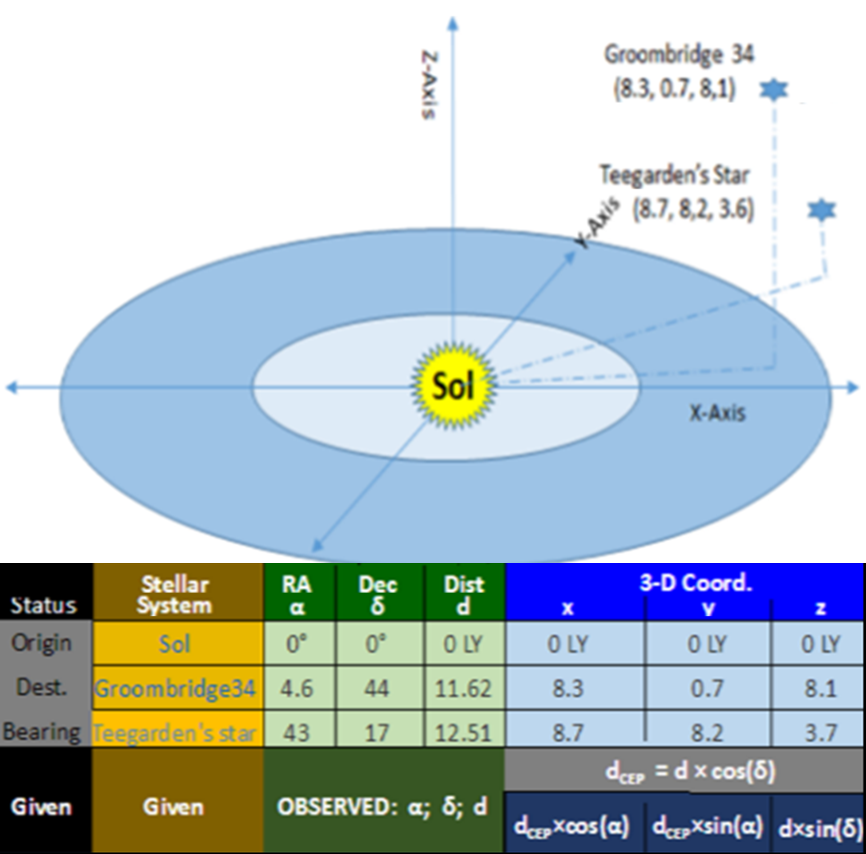A vessel can obtain a star’s bearing (angle) to its course line at anytime during a voyage. Each bearing can produce a
Line of Position (LOP). When multiple LOPs cross course line at same position at same time, navigator resolves a successful "fix" to greatly increase confidence in ship's position. During cruise (constant velocity portion of voyage), multiple fixes help the navigator accurately predict future positions, i.e.,
“Dead Reckoning” (DR).
Note following related concepts:
| HUBS: Sol's closest stellar neighbors might help replenish vessels on way to even further stars. |
| OCTANTS: TE groups neighboring stellar systems into 8 octants. Thus far, humanity has discovered about 51 systems within 15 LYs of Sol. |
CHOOSE DESTINATION
 |
GOAL: Reorient traditional coordinate system to establish course line from Sol to Destination.
Step 1) Convert traditional observations (RA, Dec and Dist) to 3 Dimensional Cartesian Coordinates (X, Y, Z) as shown in Table.
NOTE: The X,Y Axes are on the Celestial Ecliptic Plane (CEP), extension of Earth’s orbital plane.
EXAMPLE: Groombridge 34 (G34) is a nearby stellar system. one of about 34 known systems within 15 LYs distance from Sol. |
|---|
|
|---|
CONSTRUCT COURSE LINE
STEP 2a) Rotate entire 3D axes 4.6 deg counterclockwise about Z-axis to align X-axis directly under Groombridge 34.
STEP 2b) Tilt 3D axes 44.0 deg upward to align X-axis along course line from Sol to Groombridge 34. |
 |
|
|---|
Flight planner can mark course line for distances and corresponding durations.
Crew members must know exact progress along course line
because vessel must start deceleration exactly as planned.
NOTE: Earth observes acceleration phase to take 1 year of duration and distance of .377 Light Year (LY). Assume deceleration as the same.

In contrast to Earth, vessel observes acceleration time of .9 year for same .377 LY. Relativistic effects significantly impact all vessel times at high speeds.
Thus, relativistic distance/duration might be fuzzy variables
which require independent means to confirm.
This can be done by precise bearings sighted from nearby stars.
|
CHOOSE BEARING STAR
 | STEP 1) CONVERT OBSERVED TRADITIONAL VALUES TO 3D CARTESIAN COORD.
EXAMPLE: Determine traditional 3D coordinates for observed values of selected bearing star, Teegarden's Star. |
|---|
|
|---|
ALIGN X-AXIS WITH COURSE LINE
STEP 2) Realign all axes such that new X-axis extends from Sol to Destination (i.e. “Course Line”).
Thus, subtract Right Ascension (RA) and Declination (Dec) from all non-Origin (0, 0) values as shown.
Recompute three dimension (3D) coordinates of bearing with respect to tilted Common Ecliptic Plane (CEP).
NOTE: Polarity of bearing star’s declination switches from positive to negative. |  |
|---|
|
|---|
REALIGN BASE PLANE (Z=0)
 | STEP 3) Realign Base Plane (Z=0) such that X-axis and Bearing star are coplanar. Thus, normalize bearing star's Dec as shown.
Rotate the CEP 27° around the course line (i.e., new X-axis). This reduces bearing star’s declination to zero which also zeros out the Z coordinate.
|
|---|
|
|---|
 |
|---|
 |
|---|
 |
|---|
SUMMARY:
Navigators can use time tested methods to determine Lines of Position (LOPs) during interstellar voyages. Examples include:
1) Simplest LOP is course line from from Sol to destination star.
2) Sextant sighting angles to nearby stars can generate additional LOPs.
When multiple LOPs cross course line at same position at same time, navigator has a successful "fix" to greatly increases his confidence in ship's position. During cruise (constant velocity portion of voyage), multiple fixes help the navigator accurately predict future positions.
CONCLUSION: Bearings enable interstellar vessels to precisely track remaining distance.
This will prove essential for decelerating at exact, required distance to destination.

0 Comments:
Post a Comment
<< Home